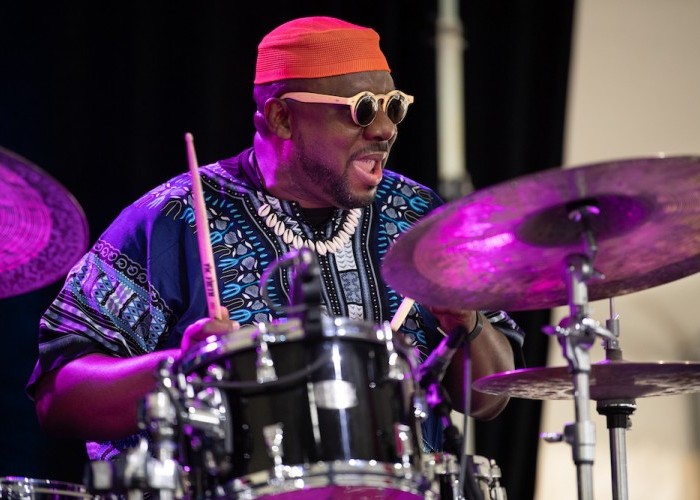Apr 2, 2024 12:59 PM
Saxophonist, Sonic Explorer Casey Benjamin Dies at 45
Casey Benjamin, the alto saxophonist, vocalist, keyboardist and producer who stamped his distinctive sounds on the…

Ralph Peterson teaches at Berklee College of Music in Boston.
(Photo: Steven Sussman)Peterson explains the switcheroo on the album’s title: “I flipped the words of [‘Venture Inward’], because my journey has been an inward venture—spiritually and physically. And, like the insignia of the label, they are interchangeable and mean the same thing. So, that’s not a typo. The record is called Inward Venture; the tune is called ‘Venture Inward.’”
The drummer swings ferociously on the three uptempo romps and opens up a polyrhythmic flurry on the kit on his 6/8 composition “Soweto 6,” which originally appeared on his first album 30 years ago. He also displays a sublime touch with brushes on the standard “I Hear A Rhapsody” and his own gorgeous ballad, “Mom.” Says Peterson, “Walter Davis gave me my first gig in New York, so I better know something about playing brushes. My brushwork is not often talked about, but I take it as seriously as the bombast.”
The striking cover art for Inward Venture—by Connecticut-based neo-expressionist artist Andres Chaparro, who also did the cover art for Peterson’s previous Aggregate Prime release, 2017’s Dream Deferred—is a provocative political statement in itself. Depicting a series of dates in the background next to a Basquiat-like image of a figure (maybe Peterson himself), it includes bold capital letters sprawled in red: AMERIKKA. Underneath that heading is a list of dates corresponding to the deaths of Harriette Moore, Medgar Evers, Malcolm X, Rev. Martin Luther King Jr., Fred Hampton, Trayvon Martin, Eric Garner, Michael Brown, Tamir Rice, Eric Harris, Alton Sterling and Philando Castile. “It also includes the date of the first arrest of Martin Luther King [Feb. 21, 1956] and his arrest number [7089] that hangs around his neck in that famous mug shot of him from the Montgomery, Alabama, jail,” adds Peterson. “There’s all kinds of subtle and not-so-subtle messages embedded in the cover. It reflects a social conscience and a desire to speak to the problem. So, I don’t mind putting out projects that provoke the listener to stop and think.”
Peterson formed his Onyx Records on Oct. 10, 2010, partly as a response to his entire Blue Note catalog of the late ’80s and early ’90s going out of print. “The whole concept, in a digital age, of a record being unavailable and out of print is so ass-backwards,” he says. “It’s beyond me why it’s done. Rather than trying to figure it out, I’m working on a solution. Eventually, I will re-record on my label every tune I’ve ever recorded on every Blue Note record that’s currently out of print.”
He explains that the seed for forming Onyx was planted 30 years ago by a comment from saxophonist Gary Bartz. “After I got a recording deal with Blue Note in 1987, I was all pumped up about being in the music business, and Bartz told me, ‘Man, you ain’t in the music business. You’re just employees.’ And he was right. Now, I’m very mindful of telling my students, ‘Recognize the game. It’s about empowerment.’”
In the weeks following the initial interview for this article, Peterson received a new diagnosis. The cancer has returned and spread to his lymph nodes. He was scheduled to begin a new round of oral chemotherapy in September, yet he remained optimistic that his treatment would not cause him to miss any gigs or teaching. “Performance is vital to me keeping positive,” he said over the phone. “It’s therapeutic, it’s cathartic, it energizes me, it strengthens me, it distracts me. Instead of sitting around worrying about what these test results are going to be, I gotta keep my head and my spirit in a place that inspires these kids who are just coming into Berklee.
“I’ve got projects out in front of me; I’m not done,” he continued. “I’ve got concerts coming up with the big band and Aggregate Prime, I’ve got another Fo’tet project coming and I will be touring with The Messengers Legacy band in the spring of 2019 in conjunction with Art’s 100th birthday.” He pauses, takes a deep breath and adds, “Yes, it’s a lot, but it keeps me occupied, honest and the hell out of trouble.” DB

Benjamin possessed a fluid, round sound on the alto saxophone, and he was often most recognizable by the layers of electronic effects that he put onto the instrument.
Apr 2, 2024 12:59 PM
Casey Benjamin, the alto saxophonist, vocalist, keyboardist and producer who stamped his distinctive sounds on the…

“He’s constructing intelligent musical sentences that connect seamlessly, which is the most important part of linear playing,” Charles McPherson said of alto saxophonist Sonny Red.
Feb 27, 2024 1:40 PM
“I might not have felt this way 30 to 40 years ago, but I’ve reached a point where I can hear value in what people…

Albert “Tootie” Heath (1935–2024) followed in the tradition of drummer Kenny Clarke, his idol.
Apr 5, 2024 10:28 AM
Albert “Tootie” Heath, a drummer of impeccable taste and time who was the youngest of three jazz-legend brothers…

“Both of us are quite grounded in the craft, the tradition and the harmonic sense,” Rosenwinkel said of his experience playing with Allen. “Yet I felt we shared something mystical as well.”
Mar 12, 2024 11:42 AM
“There are a few musicians you hear where, as somebody once said, the molecules in the room change. Geri was one of…

Henry Threadgill performs with Zooid at Big Ears in Knoxville, Tennessee.
Apr 9, 2024 11:30 AM
Big Ears, the annual four-day music celebration that first took place in 2009 in Knoxville, Tennessee, could well be…